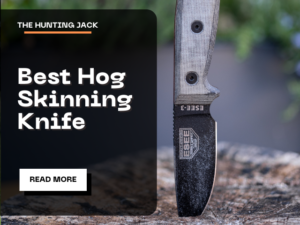I don’t know about you, but I hate being defeated by the cold. It can ruin your entire day when you have to cut your hunt short to go home and warm up under the covers.
The truth is, staying warm in cold temperatures isn’t hard if you’re prepared. If you wear the right gear, eat the right foods, and keep your body moving, you should be able to last a whole hunt quite comfortably.
Read on for some helpful obvious and not-so-obvious tips for hunting in cold weather.
Table of Contents
Toggle1. Avoid Wetness
Extremely cold weather typically consists of cold air, cold winds, rain, and/or snow. Being directly exposed to these elements is a guaranteed way to lose body heat in seconds, especially when your clothes are wet.
That’s why it’s essential to stay well-insulated to conserve your body’s natural heat. When wet clothes touch the warm layer above your skin, you will be miserable and cold. More importantly, you’ll be at risk of hypothermia – something to avoid at all costs!
Here are some ways to avoid wetness and stay dry while hunting:
- Wear rain gear. Rain gear is made of waterproof and breathable materials. I recommend wearing a rain jacket or rain poncho. It doesn’t matter which, just as long as the clothing item repels water.
- Limit your sweating. Did you know that during intense exercise, you can lose up to 85% of your body heat through sweating? This is bad news when you’re trying to stay warm. You can limit sweating by dressing lighter at the start of your hunt and gradually adding layers as you go. Also, remember to shed layers as and when needed.
- Avoid wearing cotton. You may have heard that you should never wear cotton while hunting. Do you know why? It’s because cotton absorbs sweat and keeps it close to your body. When the fabric is soaked with moisture, it loses its ability to retain warmth.
- Pack a waterproof tarp. This is useful when taking a break and needing shelter from the rain. This is an easy way to keep your hunting gear dry too.
- Dress in layers. Wearing multiple layers traps pockets of air that are kept warm by our natural body heat. I recommend always wearing three layers: a base layer, a middle layer, and an outer layer. More on this later!
2. Keeping Your Head, Hands, and Feet Warm
A common misconception is that we lose up to 80% of our body heat through our heads. In reality, it’s closer to 7-10%. Nevertheless, keeping your head insulated is still a great way to stay warm while hunting.
How to keep your head warm while hunting:
- Wear a face mask or balaclava. This will keep your head warm by covering your ears and face. Look for masks and balaclavas made from insulating materials, such as fleece or thermal fabrics.
- Wear a hunting jacket with a hood. It’s a good idea to make use of jackets with hoods. Adjust the hood over your head to protect yourself from cold winds. I would slip a heating pad into the hood as a sneaky source of warmth.
Our hands and feet often feel the cold first before it spreads to the rest of our bodies. That’s why it’s so important to keep them warm and toasty. Warm hands and feet keep blood flowing to all the right places and prevents frostbite.
How to keep your hands warm while hunting:
- Wear gloves. The best type of gloves for cold conditions are well-insulated. Imagine digging around in the snow to find antlers on a shed hunt. Without a decent pair of insulated gloves, your fingers would seize up from the cold. Even if you weren’t digging in the snow, wearing gloves is always a great way to keep your hands warm in any situation.
How to keep your feet warm while hunting:
- Wear thick wool socks. Wool fibers are naturally good insulators. They trap heat close to the skin while wicking away moisture. Wool fibers also have a natural crimp, which gives them a greater surface area to trap heat and keep blood flowing.
- Wear rubber boots. A good quality pair of rubber boots will not necessarily warm your feet. The reason I’m suggesting them is rather to avoid your feet getting wet, which would then eventually lead to cold feet. Rubber boots prevent water from reaching your feet from the get-go.
3. Layers, Layers, Layers
Layering is essential if you want to stay warm while hunting. It keeps heat close to the body and creates a barrier between the body and the cold air outside. To discuss this in more detail, let me break down the three layers I mentioned earlier: the base layer, the middle layer, and the outer layer.
For the base layer, you will need something with a moisture-wicking material. This includes merino wool and synthetic fabrics. What’s special about these fabrics is that they keep sweat away from your skin. This is exactly what you need to stay dry and warm.
Next is the middle layer. The main purpose of this layer is to retain body heat. Fleece, wool, or synthetic materials like Thinsulate, are good options here. These materials effortlessly trap body heat and help you stay warm while hunting.
Last but not least is the outer layer. This layer should be made of waterproof, breathable material. A great example is Gore-Tex. Gore-Tex is amazing because it allows sweat to escape while preventing water from getting in. This is what makes it a perfect material for cold-weather hunting.
4. Calorie-Rich Diet
Make sure to eat foods high in healthy proteins, fats, and carbohydrates. When you eat calorie-rich food, your body starts burning calories to metabolize the food. When your body burns calories, it generates heat. This is what you’re trying to achieve.
Top tip: I usually pack a tuna mayo sandwich on whole-wheat bread as my lunch while hunting. Tuna is an amazing source of protein, while whole-wheat bread is a complex carb. To make this a perfectly balanced meal, throw in some nuts and seeds to provide you with healthy fats.
This will give you all the energy you need for a successful hunt.
5. Keep Moving
Staying on the move helps you stay warm by increasing your blood flow and metabolism. Increased blood flow brings more oxygen and nutrients to your body’s tissues and fuels the metabolic processes that generate body heat.
On the other hand, if you stay sitting still, your blood flow and metabolism will start to decrease. It causes a decline in body temperature since your body isn’t working to send oxygen around and burn calories.
This could mean doing some light stretching or a few on-the-spot exercises. Perhaps take a walk and learn how to shed hunt while you’re at it.
6. Warm Up Your Tree Stand
Another way to stay warm during cold weather hunting is to get creative with your tree strand. Here are a few ideas:
- Set your stand up against the elements. Be sure not to set up your tree stand in an area with heavy rain or snow. You want to be somewhere where you know you’ll be protected.
- Insulate your floor and walls. This will help to trap heat and keep the stand warm. You can use materials like foam insulation or an insulated blanket.
- Add blinds to your treestand. You can use blinds to drape all around your treestand to protect yourself from cold winds or blowing wind and rain.
- Bring a portable heat source. A propane heater or a battery-powered heated blanket will keep your tree stand warm. Just remember to be careful that nothing catches alight.
- Bring a blanket: Having a warm wool blanket in your tree stand means you can cocoon yourself tightly in it to retain warmth.
7. Start a Fire
Starting a fire is the traditional way to up your body temperature. Just ask the cavemen.
Fire brings warmth and comfort and is especially helpful when you’re wet and need some drying off. It can also be a life-saver when your body is at risk of hypothermia.
How to start a fire:
- Gather materials like dry tinder (small twigs, leaves, dry grass, etc.), kindling (small branches and sticks), and larger logs for fuel.
- Clear an area and create a ring or pit with stones or rocks to contain the fire.
- Prepare the tinder by piling it in the center of the fire ring or pit. Make sure it’s dry and easily combustible.
- Place the kindling in a teepee shape around the tinder, leaving enough space for air to circulate.
- Use matches, a fire starter or fire steel to ignite the tinder. Blow gently on the tinder to help it catch fire.
- Once the fire is established and the kindling is burning well, add larger logs to the fire. Be sure to add the logs in a way that allows for good airflow and doesn’t smother the fire.
Once you have a steady fire, you can warm up your hands, feet, and entire body. Make sure never to leave the fire unattended. When you’re ready to extinguish the fire, let it burn down to ash and douse it with water to ensure it’s completely out before leaving.
Frequently Asked Questions
What is the warmest hunting gear for cold weather?
Some of the warmest hunting gear includes merino wool long sleeves, fleece jackets, wool socks, and thermal face masks or balaclavas. These materials are designed to insulate and lock heat in, even in extremely cold conditions.
Are heated jackets good for hunting?
Heated jackets can be a good option for hunting in the cold as they provide an additional source of warmth. They typically work by using battery-powered heating elements, which are built into the jacket. If you plan to hunt in extremely cold conditions, you can’t go wrong with this purchase.
How can I keep my toes warm while hunting?
Wear thick wool socks to keep your toes warm and rubber boots to insulate your toes from the outside cold. You can even layer your socks for additional warmth.
How can I stay warm while sitting still for long periods?
It can be difficult to stay warm while sitting still, especially if you are in a tree stand or blind. Insulated clothing and a good pair of gloves or mittens can help. A good tip is to use heat packs, which you can tuck beneath your vest or place in your gloves or boots.
Final Thoughts
When you’re on a cold-weather hunt, it’s important to stay warm. Besides layering and wearing all the right materials, remember to eat a calorie-dense meal and bring along some blankets or a portable heater for your tree stand. And if you know the basics of starting a fire, staying warm won’t be too hard.
Make sure to share this article with your friends who also want to know how to stay warm while hunting. Have fun and stay toasty!



